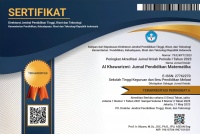TINGKAT MOTIVASI BELAJAR SISWA DALAM PEMBELAJARAN MODEL DISCOVERY LEARNING PADA MATERI BARISAN GEOMETRI TAK HINGGA
DOI:
https://doi.org/10.46368/kjpm.v5i2.3661Abstract
Â
Abstrak: Penelitian ini bertujuan untuk menganalisis tingkat motivasi belajar siswa yang diajarkan menggunakan model discovery learning pada materi barisan geometri tak hingga. Metode penelitian yang digunakan adalah metode kuantitatif dengan survei sebagai teknik pengumpulan data. Responden penelitian ini terdiri dari 35 siswa kelas 10 di salah satu sekolah menengah atas. Data dikumpulkan melalui kuesioner yang disusun untuk mengukur variabel motivasi belajar siswa. Hasil penelitian menunjukkan bahwa tingkat motivasi belajar siswa dalam pembelajaran dengan model discovery learning tidak berkontribusi secara signifikan terhadap peningkatan motivasi mereka. Penelitian ini diharapkan dapat memberikan wawasan untuk pengembangan metode pengajaran yang lebih efektif dan kreatif di masa mendatang, serta meningkatkan pemahaman siswa terhadap materi matematika.
Â
Kata Kunci: Motivasi Belajar, Discovery Learning, Barisan Geometri tak hingga, Pembelajaran.
 Â
Â
Abstract : This study aims to analyze the level of learning motivation of students taught using the discovery learning model on the material of infinite geometric sequences. The research method used is a quantitative method with a survey as a data collection technique. The respondents of this study consisted of 35 10th grade students in a high school. Data were collected through a questionnaire designed to measure the variables of student learning motivation. The results of the study indicate that the level of student learning motivation in learning with the discovery learning model does not contribute significantly to increasing their motivation. This study is expected to provide insight for the development of more effective and creative teaching methods in the future, as well as improve students' understanding of mathematics material.
Â
Keywords: Learning Motivation, Discovery Learning, Infinite Geometric Sequences, Learning.
References
Hambal, M., & Khoiruddin, M. F. (2020). Pengaruh Aplikasi Metode Discovery Learning Dalam Meningkatkan Motivasi Belajar Siswa di MTs Pondok Pesantren Salman Al-Farisi Karanganyar Solo. Tadarus, 9(2), 31–44. https://doi.org/10.30651/td.v9i2.6757
Khasinah, S. (2021). Discovery Learning: Definisi, Sintaksis, Keunggulan dan Kelemahan. Jurnal MUDARRISUNA: Media Kajian Pendidikan Agama Islam, 11(3), 402. https://doi.org/10.22373/jm.v11i3.5821
Melatisari, A. A. (2022). Discovery Learning Model To Improve The Learning Achievement Of Class 1 Students. 5(5), 602–607.
Nasional, D. P., Jenderal, D., Mutu, P., Dan, P., Kependidikan, T., Penjamin, L., Pendidikan, M., & Jakarta, D. K. I. (2006). Model-Model Pembelajaran.
Sanga, L. D., & Wangdra, Y. (2023). Pendidikan Adalah Faktor Penentu Daya Saing Bangsa. Prosiding Seminar Nasional Ilmu Sosial Dan Teknologi (SNISTEK), 5(September), 84–90. https://doi.org/10.33884/psnistek.v5i.8067
Sugiyono.(2019). Metode Penelitian Kuantitatif, Kualitatif, Dan R&D. Bandung: Alfabeta
Downloads
Published
How to Cite
Issue
Section
Citation Check
License
Authors who publish with this journal agree to the following terms:
1. Authors retain copyright and grant the journal right of first publication with the work simultaneously licensed under a Creative Commons Attribution License that allows others to share the work with an acknowledgement of the work's authorship and initial publication in this journal.
2. Authors are able to enter into separate, additional contractual arrangements for the non-exclusive distribution of the journal's published version of the work (e.g., post it to an institutional repository or publish it in a book), with an acknowledgement of its initial publication in this journal.
3. Authors are permitted and encouraged to post their work online (e.g., in institutional repositories or on their website) prior to and during the submission process, as it can lead to productive exchanges, as well as earlier and greater citation of published work.






